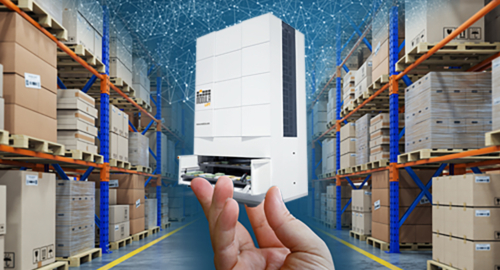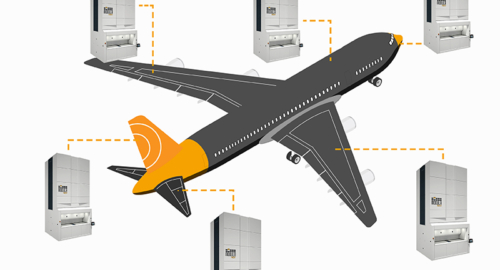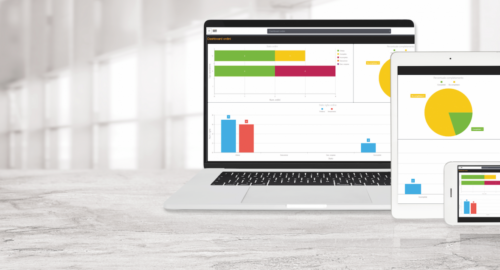The combination of Robotics and Automation is rapidly becoming an important success factor in terms of innovation and growth in all industrial sectors.
In recent years, autonomous mobile robots (AMR) have spread widely in the market, proving to be an important resource, especially when used in the context of 4.0 logistics and in combination with automatic storage systems.
According to the IFR (International Federation of Robotics), the global market for autonomous mobile robots has been growing steadily with growth forecasts of up to 40% per year. The use of industrial robots in factories around the world is accelerating at a high rate: 126 robots per 10,000 employees is the new global average density of robots in manufacturing industries, almost twice the number registered seven years ago (in 2015 it was 66).
MiR (Mobile Industrial Robots) is a company that has been manufacturing autonomous mobile robots since 2015 and experienced significant growth in 2021 thanks to its increasingly powerful robots, which can adapt to many different environments and transport even very heavy materials.
The winning combination to make the most of this type of product is achieved when mobile robots are integrated with other warehouse automation solutions, such as vertical or horizontal automatic storage systems.
To begin with, let’s take a look at AMRs, their advantages and how many types are currently available.
What are mobile robots and what are their main advantages?
Autonomous Mobile Robots (AMRs) are devices that can perform tasks and move around the warehouse autonomously.
This technology was developed to transport materials within industrial spaces without human intervention. AMRs map the surrounding space and move autonomously and safely thanks to the use of sensors and artificial intelligence.
If you want to learn more, read our article: Autonomous Mobile Robots (AMRs): how they work and how they can become part of a warehouse
AMRs are very useful tools for improving efficiency, speed and accuracy, and are very flexible in terms of configuration, in fact they can adapt their routes very quickly even when faced with sudden changes. They also have low maintenance and repair costs.
AMRs also ensure operating continuity, as they can work around the clock, increasing production efficiency and significantly accelerating the ROI.
Their use also goes hand in hand with the need to reduce the time it takes operators to move around during production processes or order preparation, or to move in areas that are dangerous or harmful to health. Sometimes working close to running machinery can cause injury or damage to people, which can be avoided with the use of robots.
This also means savings in terms of working hours and personnel, who can be assigned to more value-added activities, and above all it means safety for workers, staff, goods and machinery.
Robots also require minimal infrastructure and space, which makes them agile and flexible, and they are also very easy to programme. Moreover, they are always connected, which means that they can provide information in real-time. Communication is two-way, even with information systems and the WMS or ERP software.
Types of Mobile Robots
There are many types of robots for pulling loads, handling boxes, pallets, crates or other material, or even capable of interacting directly with Modula automatic storage systems or with conveyor belts.
AMR for pallet transport
Today, the pallet is a fundamental element not only in logistics and, more generally, in the entire supply chain, but also in the production chain where, thanks to the so-called automated palletizing systems, the goods are directly packed and delivered when ready to be handled.
The autonomous robot plays a very important role in the pallet picking/placing process by handling the packed goods within the warehouse and acting as a key link between the production and sorting steps.
Many companies integrate mobile robots as an alternative to forklifts with manipulators to optimize costs and to make production areas safer, especially when very heavy goods need to be transported.
Hook and Picking Cart
In some cases, especially when many orders have to be fulfilled at the same time, it can be convenient to use a mobile put-to-light system, the so-called picking cart, for picking.
This cart, properly loaded, can be transferred efficiently between different areas of the plant or warehouse.
The picking cart can be moved manually or automatically, with a high-capacity mobile robot pulling it by means of a special “top module” equipped with a towing hook.
AMR and anthropomorphic robots
Many warehouse processes can be performed by anthropomorphic robots, that is, industrial automation devices designed to reproduce certain characteristics of human movement, so as to replace it for certain tasks: on assembly lines, when orienting an object, or in combination with machine tools.
Modula storage systems can be used in conjunction with MIR mobile robots carrying an anthropomorphic robot which, once it has approached the automatic vertical storage system, will do the picking directly from the tray in the bay.
This application is particularly useful for picking individual parts when the robot replaces the human presence.
Total automation with the AMRs manufactured by Mir and Modula storage systems
Within companies, efficient intralogistics requires certain fundamental characteristics such as the rapid storage of goods, their rapid handling through picking and placing operations, and the complete management of flows through simple and intuitive software.
The combination of MiR’s AMRs with Modula’s automatic vertical storage systems allows goods to be picked, stored, and handled in complete autonomy.
The WMS software of the Modula storage system and the MiR Fleet are interactive, thus ensuring precisely synchronized operations.
The vertical storage system prepares the material and places it in its own loading/unloading bay.
The MiR robot, equipped with a dedicated top module capable of picking and placing the trays containing the material, comes in front of the bay and autonomously picks up the tray, then heads to the destination and delivers the material.
This solution is modular and scalable, in fact it is able to adapt to many situations with different characteristics, also thanks to the quick installation procedure.
The implementation of the AMRs by MiR and of the storage systems developed by Modula does not require any structural modifications.
This new solution proposed by the two companies offers numerous advantages, since the combination of two technologies increases the level of automation in intralogistics, ensuring significant savings in time and space. It also enhances the value of the operators, who from now on will no longer have to perform repetitive, demanding, and dangerous tasks.
Want to know more?



